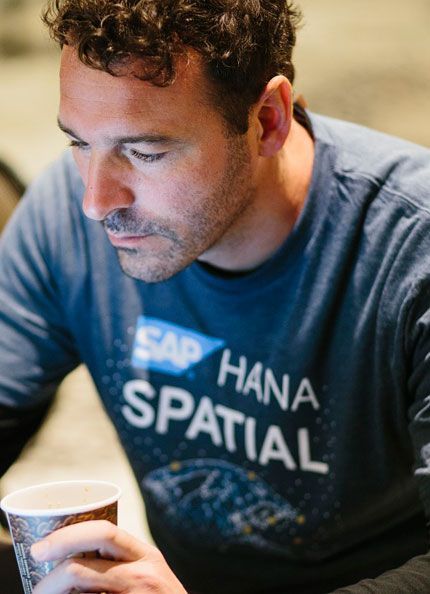
This free online course introduces SAP HANA graph and describes possible use cases, as well as showing you how to expose data to SAP HANA graph via nodes, edges, and workspaces, and much more. This course is aimed at data scientists, application developers, and technical business analysts.
This course was retired in October, 2023.
Please note: There is updated learning material related to the topic of this course available on sap.com I Start your SAP HANA Cloud guided experience.
Kurssprache: English
Untertitel (automatisch erzeugt): Deutsch, English, Français, Español
Kursinformationen

This course was retired in October, 2023.
Course Summary
Today, enterprises and organizations collect and analyze huge volumes of data that is increasingly connected. Traditional approaches of storing and processing data in relational databases are insufficient when it comes to analyzing “connections” efficiently. In the recent past, graph databases have proven their suitability for novel types of use cases. For example, manufacturing companies analyze their value chains (supply – production – sales) and ask questions like “how does a change in the price of raw materials impact the margins of my finished products?” Utility companies need to understand their network and plan and evaluate outages within an electricity grid. Public safety organizations draw conclusions from suspects and their relations in a social network.
SAP HANA graph provides built-in algorithms and programming models to analyze connected data. As an integral part of the SAP HANA platform, SAP HANA graph combines and bridges the worlds of relational and connected data, thereby reducing system landscape complexity and providing real-time graph analysis. Furthermore, graph analysis can be easily combined with other SAP HANA engines, for example full-text search and geospatial analysis, making SAP HANA an ideal platform for multi-modal applications.
This course starts with an introduction and use case descriptions. After explaining how to expose data to SAP HANA graph via nodes, edges, and workspaces, we will walk you through pattern matching queries and built-in algorithms. Unit 5 is about GraphScript, a domain-specific language for custom graph algorithms. After taking a side-step into SAP HANA hierarchies in SQL, we will talk about some integration options with adjacent technologies like full-text search and spatial. The learning units will be accompanied by system demos.
Here is what some participants are saying about the course:
"For me the topic of this course was very informative. Markus did magnificent job presenting the material in a way that is quite easy to understand even if somehow complex (at least for me). The pace is just right..."
Read the original post"I liked the course structure and content, especially the demos with actual code samples and results. The examples where also varied and helped tremendously with going from the abstract concept of a graph made of nodes and edges to mapping relations an event laying them out on a map…"
Read the original post"Being an SAP ABAP developer myself, I really loved the detailed description on GRAPH SEARCH algorithm for full text search, which is much more easier in HANA and understandable. I can see using this algorithm to be used in VPS( Visual Positioning System) to replace the GPS, an that will definitely make a history in the world of technology…"
Read the original post
Course Characteristics
- Starting from: June 20, 2018, 09:00 UTC. (What does this mean?)
- Duration: The course is open for 4 weeks
- Effort: 4-5 hours in total
- Course assignment: You can take the course assignment at any time whilst the course is open.
- Course closure: July 19, 2018, 09:00 UTC
- Course language: English
- How is an openSAP course structured?
Course Content
- Unit 1: Connected Data and SAP HANA Graph - Introduction and Use Cases
- Unit 2: The Basics: Nodes, Edges, and Workspaces
- Unit 3: Pattern Matching
- Unit 4: Built-In Algorithms
- Unit 5: GraphScript
- Unit 6: SAP HANA Hierarchies
- Unit 7: Beyond Graph: Full-Text Search and Spatial
Target Audience
- Data scientists
- Application developers
- Technical business analysts
Course Requirements
- Basic database knowledge
- Basic understanding of full-text indexing and search applications is helpful
Lernmaterial
Course content no longer available
Course
I Like, I Wish:
We Love Your Feedback … And Want MoreSAP Learning Hub discount
Für diesen Kurs einschreiben
Lernende
Bewertungen
Der Kurs wurde mit durchschnittlich 4.48 Sternen bei 491 abgegebenen Stimmen bewertet.
Anforderungen für Leistungsnachweise
- Den Leistungsnachweis erhält, wer in der Summe aller benoteten Aufgaben mindestens 50% der Höchstpunktzahl erreicht hat.
- Die Teilnahmebestätigung erhält, wer auf mindestens 50% der Kursunterlagen zugegriffen hat.
Mehr Informationen finden Sie in den Richtlinien für Leistungsnachweise.
Dieser Kurs wird angeboten von

Markus Fath is a development architect for SAP HANA. His focus is on multi-model processing, which includes SAP HANA’s spatial engine, graph engine, and the JSON document store.
Markus frequently works with customers solving real-world problems using SAP HANA’s spatial features and custom graph procedures. He also holds presentations and runs workshops at public and internal SAP events and writes blogs about SAP HANA multi-model use cases.